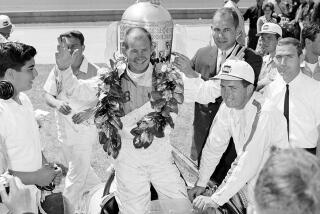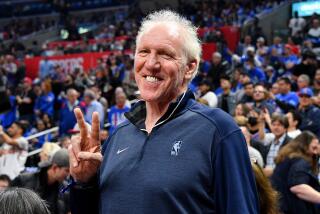Owner, Driver and a Meeting of Mind : Auto racing: Darrell Waltrip gets faster at the track he loves to hate when he stops being a ‘good buddy’ in the shop.
- Share via
DAYTONA BEACH, Fla. — It has been 12 years since Darrell Waltrip won the last of his three Winston Cup championships, six years since he won his only Daytona 500 and more than a year since he won a Winston Cup race anywhere.
He turned 47 two weeks ago and has been in 21 Daytona 500s in a row--more consecutive starts than any other driver in Sunday’s field.
So what does he think of his chances?
“I firmly believe that this is the best team I’ve ever had, even including the ones in years when I won 12 races,” he said. “We (had the sixth-fastest car) but ran into some bad luck Thursday when the Hoosier tires didn’t do the job the way we thought they would.
“We’ll be back on Goodyears for Sunday’s race, and I expect to be back where we were when we had the best winter I’d ever had testing at Daytona and Talladega (in Alabama).”
The veteran driver from Franklin, Tenn., was speaking as both owner and driver of the gleaming No. 17 Western Auto Chevrolet Lumina he will start in 32nd position in Sunday’s race. “My rule of thumb at Daytona has been if I qualify well, I run well,” Waltrip said. “I qualified well, but I didn’t run well Thursday. But I know why and we’ve taken care of the problem. I don’t see any problem in running from where we start. It just means getting through more traffic.”
In 1989, when Waltrip won the 500, he had qualified second. But there is precedent for winning from as far back as Waltrip will start. Bobby Allison won from 33rd in 1978 and Benny Parsons from 32nd in 1975. More recently, Bill Elliott started 38th and won the Firecracker 400 at Daytona in 1988.
Waltrip also finished second in 1979 and third three years in a row from 1984-86. He has also won five Twin 125 heat races, five Busch Grand Nationals, one IROC and one Busch Clash at Daytona.
“To tell the truth, I have a love-hate relationship with Daytona,” Waltrip said. “I love to win here, but I hate the price I’ve had to pay. Of all the tracks I’ve been to in my racing career, none holds a light to Daytona (in) the bodily harm it’s done to me through the last few years.
“The accidents seem to run in cycles. From ’83 to ‘89, I had some pretty good luck here. Then, from ’90 on, it’s been a battle.”
In 1990, he formed his own Winston Cup team.
In 1991, he was involved in accidents during both the Daytona 500 and the Goody’s 300 Grand National, then had the worst accident of his career during the 1991 Firecracker 400 in July when his car was destroyed when it flipped across the wet infield grass. Waltrip sustained a black eye and multiple bruises.
When he left Rick Hendrick’s team to form his own, most NASCAR observers shook their heads in dismay. Other drivers, notably Bobby Allison, Buddy Baker, Cale Yarborough and even Richard Petty, had tried to run owner-driver teams and all had failed.
“There had been a stigma that you couldn’t do both successfully, but I think that was more because all of them were underfinanced,” Waltrip explained. “Sponsors were leery of backing them, but when we got Western Auto behind us, I felt we were ready for big things.”
Big things happened for a while--he won two races in 1991 and three in ‘92, including the Southern 500 at Darlington, S.C.--but 1993 was a loser. He not only didn’t win, he had only two finishes as high as third.
“Last year was a major learning year for the owner,” he said. “When things started going sour, I began to doubt my ability as a driver, but friends, even racing competitors, told me the problem was with the owner.
“I finally got it through my head that I was operating my team on the ‘good buddy syndrome.’ When I was not at the shop, performance dropped. When I was there, things were OK, but I couldn’t be around all the time. The answer was to clean house, get a new guy (Clyde Booth, who had been with Kenny Bernstein’s team) to run the shop and get tough.”
Waltrip also sold his Grand National, ARCA and All-Pro cars to concentrate on one thing--regaining his Winston Cup success.
“It’s funny how different the driver mentality is from the owner mentality,” he said. “I should have learned from running for Junior (Johnson) and Rick (Hendrick) that when you try to run two teams, instead of ending up with one great team, you more likely end up with two mediocre ones.
“There just aren’t enough hours in a day to do both and do them right.”
Other factors sometimes mentioned as contributing to Waltrip’s slump have been age, a growing family and the inability to say no to outside commercial activities.
Waltrip’s responses:
--On age: “Sure, I have to think about it. I’m no fool. I know I have to work harder to compete with guys 25 to 35. I used to be that age myself, and I know how I felt, but I think the way I work out, I’m as fit physically as ever. It just means more time from the schedule.
“When I was younger, 40 seemed like an age to retire. I was winning races and winning championships, but the pressure on me to win made it very difficult for me. I never thought I could take it for 20 years. I was always battling something--race politics, my car owners, other drivers, the media, the fans. It was something all the time.
“One day, I woke up to realize I couldn’t win every race, that I couldn’t worry about the ones I didn’t win. It didn’t make losing any easier, but it put it in a different perspective. That’s when I knew I could keep doing this for a long time.”
--On his family--wife Stevie and daughters Jessica, 7, and Sarah, 1 1/2: “My family is the kind you long to work for. It gives me more focus, but it’s easy for a race driver--and a race car owner--to fill his time working to make the car better. What I have to do is be sure they get from me what they need. That, and a lot of love, which is the easiest to give.”
--On off-track activity: “I’m the first to admit I like to be out in front. It’s part of my personality, but there is a limit to how many balls you can keep in the air. I hate to say no to an opportunity. . . . There are so many more opportunities now than there were a few years ago. Somewhere, you have to turn some down, but that’s a whole lot better alternative than not having any offers.”
An added emotional burden this week for every driver is the memory of Neil Bonnett and Rodney Orr, who were killed in accidents during practice.
“I wake up in the morning with a knot in my stomach and a heavy heart, and I go around all day feeling like that,” Waltrip said. “You can’t get away from it. No one here can. The worst part is when you’re off the track. You have more time to reflect on it. Your mind thinks of all the ‘what ifs?’ and there’s nothing you can do.”
More to Read
Go beyond the scoreboard
Get the latest on L.A.'s teams in the daily Sports Report newsletter.
You may occasionally receive promotional content from the Los Angeles Times.










